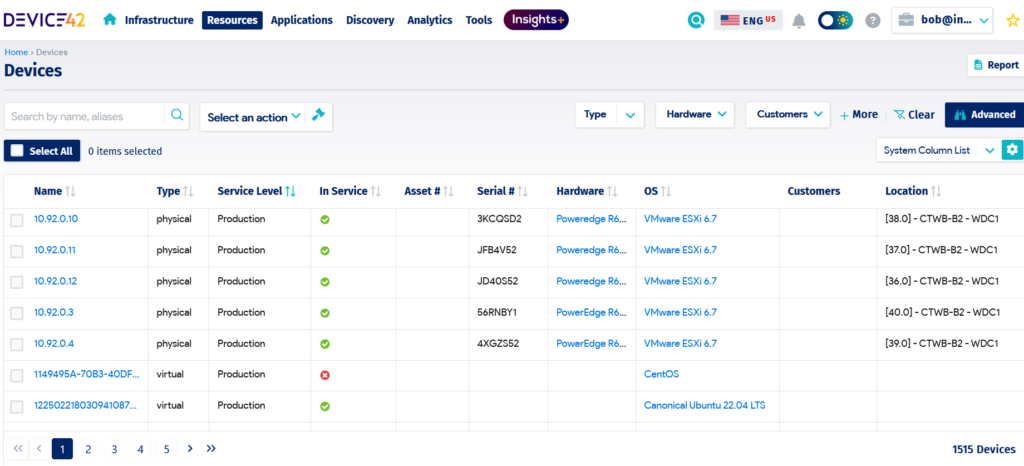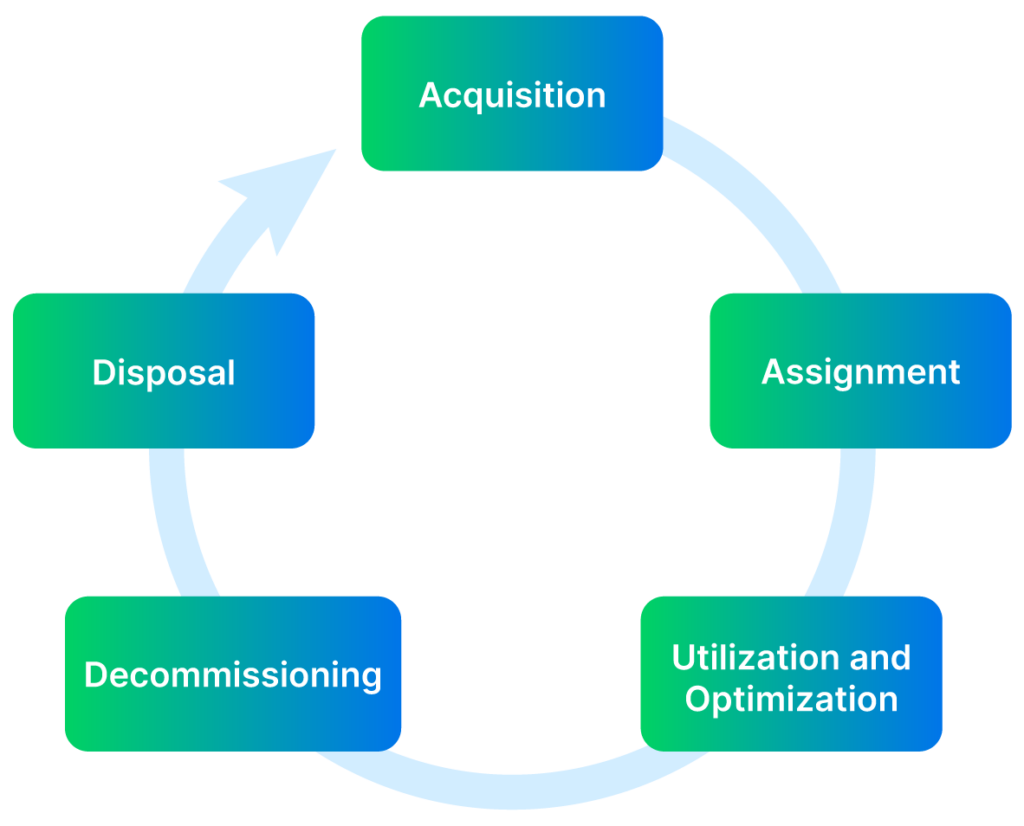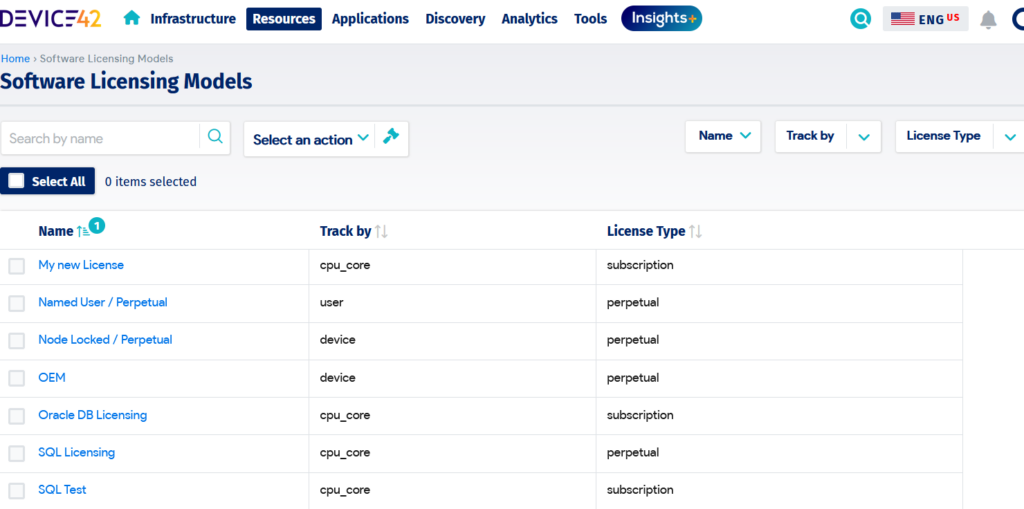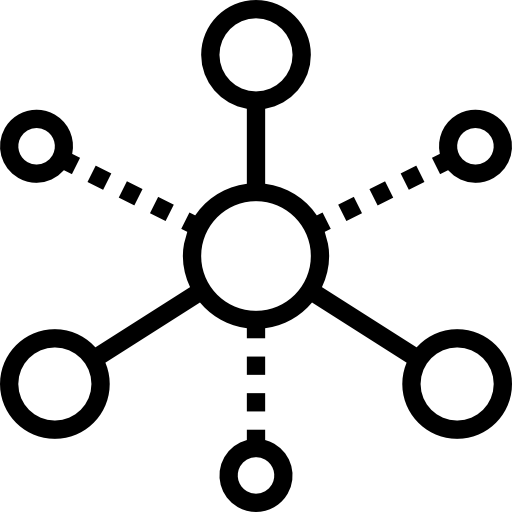A Practical Guide to IT Asset Management Tools for Modern IT Environments
While setting up internal IT tools for departments in the organization, most IT organizations encounter challenges in demonstrating value for money for the investment into IT assets made by the business. This is compounded by the growing complexity of the IT environment, which spans on-premises and cloud environments. Investing in the right IT asset management (ITAM) tools enables the IT function to better manage IT assets throughout their lifecycle to demonstrate the business value in these assets.
Most IT teams experience challenges in having complete visibility of their technology investments. This is mainly caused by siloed systems and teams, resulting in overspending on technology, higher cybersecurity and compliance risks, reduced IT service management (ITSM) data quality, and a slowed pace of growth initiatives. Addressing these issues requires IT asset management tools that track and analyze IT asset usage while integrating with other business systems to facilitate governance and enterprise value generation.
The choice of IT asset management tools is primarily informed by the operational context of the organization as well as its financial capabilities. ITAM tool selection is also informed by its strategic importance in solving IT problems that lead to business function impact. Other drivers such as strategic expansion, maturity, automation, and compliance requirements also play a big role in determining the selection of ITAM tools. Simple tools such as spreadsheets can only work in very small IT environments with little complexity or little changes—as the scale grows to multiple teams and environments, they become ineffective. Organizations should also consider security and cost factors, especially in cases where vendors can impose hefty fees for features required to capture detailed attributes or in-depth visibility across the lifecycle.
This article focuses on key features that ITAM tools deliver for organizations and guidance in selecting the right tools to meet business needs.
Summary of key IT asset management tool features
The table below summarizes the ITAM tool capabilities that we will focus on in this article.
| Key feature | Description |
|---|---|
| Inventory management | IT asset management tools provide a centralized register of all physical and virtual IT assets, both on-premises and in the cloud. |
| Lifecycle management | IT asset management tools can provide visibility during the various stages in the life of an IT asset—from planning to disposal—to facilitate enhanced utilization and resource efficiency. |
| Software license management | IT asset management tools can automate the tracking of software licenses for compliance and cost management. |
| Integration with other IT tools | Through integration, IT asset management tools can provide IT asset information to other systems such as the CMDB as well as financial and security systems. |
| Analytics and Reporting | IT asset management tools facilitate the analysis and visualization of IT asset information by providing reports and dashboards on IT asset status. |
Inventory management
The hallmark of an organized IT function is having a comprehensive and accurate picture of all its IT assets. The main feature of IT asset management tools is to provide a centralized record of all acquired IT assets, whether physical or virtual. Physical assets include servers, network devices, user devices, and data center equipment, while virtual assets include applications, cloud instances, operating systems, and certificates.
IT asset management tools maintain records in the form of a table, usually termed an IT asset register. Each entry includes fields such as unique identifiers, asset attributes, lifecycle stages, assigned personnel, responsible parties, and vendor information, among others. Some vendors tie the number of assets or the detail of the information captured to the price of the IT asset management tool.

IT asset inventory (source: Device42)
Populating the IT asset register is a critical undertaking that can derail the entire value proposition offered by your IT asset management tool if not given adequate attention.
Manually populating the IT inventory information can be a straightforward process for physical IT assets, but this is only efficient on a small scale (i.e., less than 20 devices). In large hybrid environments, the level of complexity means that manual methods cannot work efficiently, so IT asset management tools should support discovery techniques to capture most categories of IT assets within the on-premises environment and the cloud. These techniques include ping sweep, SNMP, SSH, WMI, and API; the more techniques supported, the greater the scope that the IT asset management tool can capture for the inventory.
What sets apart world-class IT asset management tools when it comes to inventory management is their capability to capture data in a form that supports the enterprise’s objectives for service delivery and value realization. Such ITAM tools can automatically discover almost all IT assets whether legacy or cloud-native, across on-premise, cloud, and virtual environments. They can also scale with the organization as it expands even to a global footprint while keeping the data fresh through repeated automated discovery to support business processes and compliance. In addition, they can quickly and effortlessly visualize IT assets across any environment highlighting detailed data including relationship information such as interdependence.
For physical IT asset inventory, an additional capability that IT asset management tools provide is the generation of barcodes or QR codes for IT asset tagging. These codes allow for the identification of the IT asset through scanning to display the attributes and facilitate action such as changing the lifecycle status or updating other information. For example, faulty devices can be checked out for repair or disposal. Barcodes are also useful when auditing physical assets, an activity that is usually required for financial reporting. IT asset management tools that generate such codes normally allow interfacing with printing tools.
Lifecycle management
The second feature that most IT asset management tools will provide is tracking the IT assets throughout their lifecycle, from planning to end of life. Having visibility on the journey of the IT asset within the organization can translate into significant benefits from both utilization and cost-saving perspectives. The capabilities that ITAM tools can provide within the key stages of the IT asset lifecycle include the following:

IT asset management lifecycle
- Acquisition: The ITAM tools will provide information on lifecycle status that informs the organization’s procurement plans for new IT systems and components. The tools generate the detailed technical information required for purchase orders or lease agreements and track changes in status from procurement to delivery acceptance and (subsequently) storage.
- Assignment: IT asset responsibility is delegated to a user (device level) or custodian (administrator). The ITAM tools generate information on potential assignment options at the individual, system, or location levels. The tools track the change in status from storage to provisioning, transportation, and assignment while also subjecting the IT asset to relevant business policies and rules, such as required security configurations, BYOD policies, etc.
- Utilization and optimization: Once assigned, the ITAM tools generate information on IT asset usage, including billing, inactivity, servicing, repair, etc. This is then analyzed to inform optimal usage by triggering required activities through the ITAM tools, such as changes, maintenance, reallocation, or decommissioning.
- Decommissioning: ITAM tools can automatically trigger the decommissioning of IT assets based on predefined rules such as the end of a warranty period, repair duration, or upgrade capability. The tools can also initiate actions such as data migration or wiping and license recovery.
- Disposal: After the decommissioning of IT assets, automatic disposal can also be triggered by the ITAM tools based on organizational policies. The tools can highlight which contracts are to be terminated, the right options for disposal, and feedback into the planning phase.
Visibility across the IT asset lifecycle can be greatly enhanced when the ITAM tools are fed with vendor information regarding contract, license, and warranty status for procured assets. Appropriate activities are then triggered throughout the lifecycle while configured alerts keep IT administrators informed. The same applies to monitoring IT asset maintenance activities such as repair, upgrade, and replacement, where information from designated vendors can be fed into ITAM tools to update lifecycle status. World-class IT asset management tools can also enrich the IT asset records with additional information from external sources such as warranty information and security vulnerabilities, which is invaluable for IT asset lifecycle management.
Software license management
The management of software licenses is a growing headache for most IT functions because major vendors such as Microsoft, Oracle, and IBM continue to tighten the noose on license compliance. The cost of non-compliance following a software license audit can be quite significant including audit fees, retroactive maintenance fees, and mandatory license upgrades. When deployed effectively, ITAM tools help IT teams avoid such fines by optimizing the management of software licenses across the IT asset lifecycle.
The capabilities required from IT asset management tools start with the discovery and centralized management of software licenses throughout the IT environment, covering licenses from vendors assigned to users and systems. In conjunction with hardware asset management, an inventory of deployed software licenses is generated and associated with the underlying hardware. IT asset management tools centralize the license inventory, capturing details such as license type and distribution rights according to relevant end-user license agreements. The best-in-class ITAM tools can generate detailed dependency information that enables organizations to link licenses with software and hardware IT assets, including visualization of relationships across on-premise and cloud environments, providing insights necessary for effective license and asset management.

Figure 3: Software Licensing Information (Source: Device42)
Once the software license information has been captured, the IT asset management tools can be configured to monitor and send alerts based on license status and compliance, including license expiry and violation of license terms and conditions. Specialized features can run compliance checks within the IT environment to check for any violations against the EULA and flag any nonconformities for remedial action. The IT asset tools can generate reports for software license audits to facilitate governance, risk, and compliance purposes, helping the organization avoid hefty fines from vendors.
IT administrators use the ITAM tools’ software license information to analyze software license assignment, consumption, and associated costs. This analysis then highlights areas where licenses can be consolidated or optimized, so the organization does not end up paying for licenses that are not being used. The planning phase of the IT asset management lifecycle can apply the results of the analysis to optimize the budget for the procurement of licenses and associated hardware and software.
Integration with other IT tools
IT asset management tools come with various types of integration options that enable the asset management practice to share information with other enterprise processes so that better decisions are made and the organization becomes more effective in extracting value from its IT asset investments. By feeding from and into the larger IT and business data ecosystem, asset management tools can extend their capabilities, which enables the organization to achieve greater efficiency and cost-effectiveness.
Some of the system integrations that can extend ITAM tools’ capability include integration with the following:
- A CMDB, for faster troubleshooting and visualizing dependency maps for impact analysis
- Financial management systems such as ERP, for tracking costs, including ROI and depreciation
- ITSM systems, to support change management, incident management, and problem management practices
- Vendor systems, to track warranty and patch status, license status, and repairs
- Security systems, for vulnerability and compliance management
- HR systems, to support user device assignment and account management processes
To cover a wide variety of third-party systems, IT asset management tools should include multiple integration options, including RESTful APIs, connectors, and webhooks, along with comprehensive documentation and easy-to-use guides for administrators.
Analytics and Reporting
High-quality, accurate data is necessary for IT asset management to support decision-making across the IT asset lifecycle. IT asset management tools usually come with out-of-the-box analytics solutions that centralize data for analysis and viewing. In addition, they may provide APIs that allow for connectivity to third-party data analytics tools that an enterprise may prefer. Whatever the approach, the main outcome is the presentation of IT asset status information in any desired format.
IT asset tools are primarily used to generate reports on IT asset lifecycle status and utilization metrics. These can be presented through dashboards or exported to spreadsheets or database tables. Other areas where common reports are generated include IT asset costs, compliance, and performance. Where integration with business systems has been implemented, advanced analytics solutions can combine the ITAM tool data with business information for more in-depth analysis. For instance, asset aging reports can be combined with depreciation information from financial management systems.
Other capabilities that advanced ITAM tools can provide include predictive analytics that enables organizations to forecast enterprise IT asset needs by analyzing historical data through machine learning and making intelligent decisions. A good example would be identifying patterns to predict potential asset failures, compliance issues, or maintenance needs. AI large language models are another recent development and can be integrated with ITAM tools so that users can have an easy way of querying IT asset information through prompts.
Limitations
As with any IT system, IT asset management tools come with their own challenges. If there is no clear understanding of business goals and IT asset management processes, chances are high that an organization can make the wrong choice of tool and end up failing to obtain value for their investment. This is especially true for organizations that fall for “shiny object syndrome,” where the leadership is easily distracted by the latest and greatest features touted by vendors and ends up changing their tools without clarity of how business outcomes will be supported.
Known implementation and adoption issues with IT asset management tools can collectively represent another limitation. Most tools have a steep learning curve for more advanced features such as discovery configuration and analytics. If an organization does not invest in advanced training, chances are high that it will always fall short of maximizing the tool’s capabilities.
Other challenges involve how IT asset management tools are designed. Some may not have the technical capacity to capture the complexity that comes with sophisticated environments, especially where old legacy IT has to be matched with rapidly evolving cloud assets.
In addition, the integration of IT asset tools with existing IT systems may not be as straightforward as envisaged. A diverse and complex environment results in differences in protocols, platforms, and software versions that can make it difficult to seamlessly integrate systems for maximum effectiveness. Also, the administrative headache that comes with an avalanche of information provided by IT asset management tools may prove to be challenging, especially for IT teams that are understaffed and have limited training.
Best practices
To make the most of the enterprise’s investment in IT asset management tools, the following best practices should be considered.
Acquire capabilities only when there is a viable use case
The selection of ITAM tools should not be made on a whim but rather based on a thoughtful process that comprehensively considers the organizational context, including current challenges with IT asset management, compliance requirements, and target enterprise architecture. The selection of features should be supported by a solid business case that ties directly with a return in the form of meeting business objectives.
Choose tools that have ready integration options with renowned IT systems, such as open APIs
A growing business will require more resources, including IT systems. The ITAM tools selected should be able to discover IT assets across the entire IT landscape—including on-premises systems, cloud environments, and remote locations—and track their status across all lifecycle stages. The best ITAM tools come with an extensive API library as connectors that facilitate easy interconnection with the most popular monitoring, ITSM, and orchestration solutions in the market. The right integration capabilities can yield a cohesive and unified information hub that facilitates better decision-making and more effective IT service management processes.
Scope and iteratively onboard IT assets
To build a comprehensive inventory of the entire IT landscape, the journey should start with a scoping exercise to determine the right approach to onboard IT assets into the ITAM tools. The approach must consider priority and business value and be planned iteratively so that verification and validation can be carried out after each cycle. Trying to onboard all IT assets in one go can introduce gaps that may be difficult to detect and address later.
Last thoughts
The choice of IT asset management tools can be critical from strategic, tactical, and operational perspectives. Achieving the right balance between business needs, required features, and available budget can be a tricky affair, but through careful consideration of all factors and input from key stakeholders, the organization can make an informed choice on the IT asset management tools that deliver the expected value on time.
The right tool can propel the organization to achieving business goals and attaining operational excellence. However, it requires that the organization find the right fit to support life cycle management and strategic decision-making for the IT environment.




